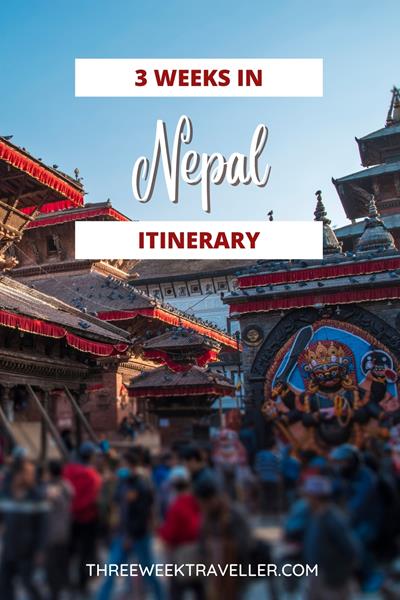Nepal is landlocked between India and China. Known as one of the gateways to the Himalayas, Nepal is a popular destination to reach the world’s tallest mountain – Mount Everest.
When I first got the idea of visiting Nepal, myy whole plan was around the Everest Base Camp trek. However, that activity takes about 14 days. This means that I have an extra week to explore other parts of Nepal.
When someone makes Nepal their next travel destination, automatically, you’d think they want to trek Everest Base Camp. While it is a top attraction, Nepal isn’t only for hikers and mountain climbers. It’s also a place for meditation, yoga retreats, and adventure-seeking.
In this 3 weeks in Nepal itinerary, I will show you two types of itineraries. One includes heavy or long treks like Mount Everest or Annapurna, and the other is without serious trekking at all. In this way, you can decide which kind of trip you should do when visiting Nepal.
It’s vital that you make a decision between doing a long trek or not because both Annapurna and Everest Base Camp take 2 weeks to trek. If you only have 3 weeks in Nepal, that would leave you 1 week in Kathmandu and 2 weeks hiking.
CHECK-OUT: 3 weeks in India itinerary
THINGS TO KNOW BEFORE GOING TO NEPAL
Before you book a flight to Nepal, there are a few things you should know and remember to help you plan your itinerary. For example, although IDP is valid in Nepal, it’s much easier to use public transportation and ride-hailing apps.
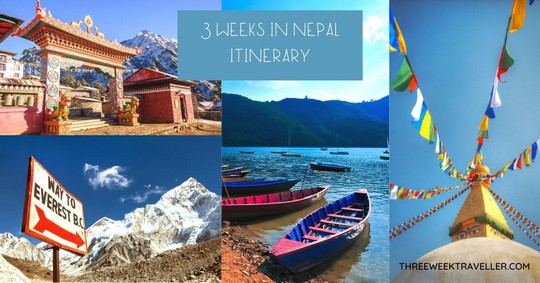
When is the best time to visit Nepal
If you plan to hike Annapurna or Mount Everest Base Camp, the best time to visit Nepal is either April to May or October to November.
The rainy season is from July to September, with heavy monsoons that can disrupt travel and trekking. When the weather is bad, and usually, the government doesn’t allow anyone to trek. There are fewer people from October to November for the EBC trek because the people who want to summit Mount Everest only go from April to May.
If trekking is not part of your plan, October to December are great months to go since there’s less chance of rain, but it can be very cold. March to May is also another perfect time to travel around Nepal when it’s a little warmer.
December to February is winter and extra dry, with cold temperatures in the mountains. March to April is shoulder season, which is great for wildlife watching and lower-altitude treks.
Getting around Nepal
Moving around the city, it’s best to take a taxi or a motorbike. There are apps you can use similar to Uber called Pathao, Taximandu, and Sahara. These apps mostly work in Kathmandu only though, but soon, they will be operating in Pokhara too. When using a regular taxi, remember to haggle.
Going from one city to another, flying or even taking the bus is best. Although Nepal is a relatively small country, it sits on top of the Himalayas. This means the travel on the road is slower and windy since you have to go through mountains.
There might be a lot of national road construction, making travelling by land a lot longer. For example, during my visit, the road from Kathmandu to Pokhara was filled with road construction. The 6-hour drive took nearly 10 hours. In that case, it’s better to book a domestic flight.
What to pack for Nepal
Even if you plan to visit during summer, it can still be chilly at night. Hence, bringing a lightweight jacket and long trousers will be smart. Bring proper hiking shoes or boots and a windbreaker/down jacket if you plan to hike.
There are a lot of beautiful and interesting temples and monasteries you can visit. You must wear conservative clothing when entering these sites. So, make sure you have long trousers and top that covers your shoulder.
Planning to do layers instead of bringing a thick jacket is highly recommended. While hiking, you’ll get warmer. You can easily remove the layers for comfort and put them on again when the temperature drops instead of packing away a heavy jacket.
You should also bring sunscreen at least SPF50, a hiking hat, and a first-aid kit. You can rent hiking equipment in Kathmandu or buy knock-off brands for more affordable prices. We have a general packing list for a 3-week trip and a winter packing list as well.
Visa
Nepal has a very straightforward and relatively easy visa policy. Nearly anyone who wishes to visit Nepal can enter using a visa on arrival, which is available for 15 days ($30), 30 days ($50), or 90 days ($125) – all these visas are multiple entries. You must apply for a visa before arriving in Nepal.
If you decided to stay longer, you can extend your visa at the Department of Immigration. They should have one in Kathmandu and Pokhara. If you plan to stay 3 weeks in Nepal, it’s better to get a 30-day visa so you don’t need to spend time visiting the immigration office.
Other basic travel tips
Here are sites and travel tools I always use when travelling anywhere in the world. If you plan to do the Everest Base Camp trek or any hike above 5,000 m, you are required to get helicopter evacuation insurance. IMGlobal covers all nationalities. This is the company I used for my hike there. Get the iTravelInsured Travel LX plan to ensure it covers the EBC trek requirement.
3 WEEKS IN NEPAL ITINERARY (no long treks)
If you want to visit Nepal solely to explore the country, learn more about the culture, eat yummy local dishes, and interact with the locals without interest in doing serious hiking, this itinerary is for you.
Nepal is a somewhat middle-sized country. In some areas, it will take only a few hours of driving to get from one city to another. In places that take more than 6 hours to drive to, you might consider taking a short flight instead.
Click the top-right icon to enlarge the map. Credit: Map Data: Google
There are actually 3 places that you can smartly use as a home base. When you get to these towns, you can easily get a hotel room for a few days or even an entire week and use this city or town as your base while you explore the surrounding areas.
For example, from Kathmandu, the capital city, you can do dozens of easy hikes and day trips. You don’t need to pack all your bags to look at accommodations outside the city, which will save you time, money, and energy.
Week 1: Kathmandu
Kathmandu is where most international flights to and from Nepal will come through. This city sits in a valley encircled by the Himalayan mountains. Unfortunately, due to the earthquake in 2015, many historical sites and infrastructures have been destroyed.
Regardless, there are many places and things to do in Kathmandu and the surrounding areas that including day trips and easy trekking trails. Here are some attractions to see in Kathmandu and day trips from Kathmandu:
Attractions in Kathmandu and surrounding areas:
- Explore Kathmandu – do the UNESCO World Heritage Sites tour or a full-day Kathmandu tour
- Kathmandu Durbar Square
- Narayanhiti Palace Museum
- Do a whole day massage and spa with lunch
- Garden of Dreams
- Ghantaghar
- Pashupatinath Temple and Bodnath Stupa – guided tour
- Shankhadhar Park
- Go white water rafting – read the tour reviews
- Dharahara Tower
- Discover Nepalese cuisine by joining a cooking class in Thamel or sign up to a walking street food tour or a walking food tour at local eateries
- Boudha Stupa
- Pashupatinath Temple
- Sunrise hike to Nagarkot – see the tour details
- Swayambhunath Temple
- Day trip to Nagarkot and Bhaktapur – book your spot
- Bhaktapur Durbar Square
- Half-day tour to Chandragiri to ride the Cable Car – look at the tour price first
- Patan Durbar Square
- Go on a helicopter tour to Everest Base Camp from Kathmandu – either over the air only or including a landing at the base camp
Here’s a list of easy hikes from Kathmandu:
- Amitabha Monastery Hike
- Kakani Hike (viewpoint at Kakani View Tower)
- Phulchowki Temple Hike
- Nagarkot Trail Hike – see the sunrise tour details
- Sundarijal Waterfall
- Shivpuri Nagarjun National Park
Where to stay in Kathmandu:
- Affordable: Flock Hostel or Shantipur Kathmandu
- Mid-range: Kumari Boutique Hotel or Hotel Jampa
- Luxury: Arushi Boutique Hotel or Hotel Blue Horizon
Week 2: Pokhara
Pokhara is only a 6-hour drive from Kathmandu or less than an hour’s flight. If you want to get away from the busy city of Kathmandu and look for more easy trail hikes, this is where you want to be.
In the heart of Pokhara is a massive lake where you can rent a boat and enjoy the sunset over the Himalayan mountains. There are many things to do here, such as visiting waterfalls, caves, temples, and trail hikes without leaving the city.
For a bit of a challenge, you can hike ancient towns and mountain peaks. Normally, the last 2 to 8 days. You can leave your luggage in Pokhara and bring only your necessities.
Pokhara is also a popular destination for locals coming from Kathmandu. The weather here is amazing and a bit more affordable than in the capital city. At night, you can walk around the Lake Side (which is the heart of the city), where restaurants, bars, and night markets can be found.
Attractions in Pokhara and surrounding areas:
- Pewa Lake
- Go paragliding – read the reviews
- Mahendra Cave
- Go Bungee jumping – see the tour price or fly over Sarangkot
- International Mountain Museum
- Davis Falls
- Zip lining – experience the world’s steepest zip-line
- Seti River Gorge
- Explore Nepalese cuisine – join a cooking class
- Pokhara Canyoning
- Visit Tibetan Settlements – either book a full-day or a half-day tour
Here’s a list of easy hikes from Pokhara:
- Muldhai Viewpoint
- Annapurna – do a day hike to the Australian camp or the Annapurna and Upper Mustang trail
- Ghandruk
- Poon Hill Sunrise Viewpoint – book a 5-day hike for Poon Hill and Ghandruk
- Dhampus View Tower
- Ghorepani Poonhill
- Panchase Hilltop Heliport
- Sarangkot View Tower
Where to stay in Pokhara:
- Affordable: Hotel Cherry Garden or Pokhara Backpackers Hostel
- Mid-range: Bodhi Suites Boutique Hotel & Spa or Hotel Middle Path & Spa
- Luxury: Hotel Portland or Bar Preepal Resort
Chitwan National Park 2-3 days
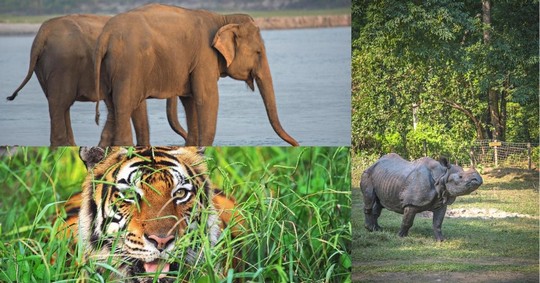
Chitwan National Park is located a 5-hour drive from Kathmandu or a 30-minute flight to Bharatpur. From Pokhara, it is a 3.5-hour drive.
Chitwan National Park is home to many wild animals, such as Bengal Tigers, Rhinoceros, Leopards, and Elephants, which are all roaming free. You can book a tour from their headquarters or from tour agencies to see the animals up close in their wild habitat.
There are also canoe trips and learning how the Park is working to protect the animals and breeding them to keep their numbers at a balanced level.
While the Park does a lot of good for these animals, unfortunately, the riding of elephants can be seen here. Do not participate in such activities. However, I also don’t want you to not come here. The animals rely on money that the Park makes to keep their natural habitat safe from poachers.
I do, however, recommend you review the park and criticise the elephant riding. The more tourists talk about it, the higher the chance that this cruel treatment of these animals will be stopped.
The Park is near the town called Sauraha, where you can find hotels and small restaurants. In the town of Bharatpur (where the airport is), there are also accommodations to choose from.
TIP: If you like Safari, here are things to know before visiting Kruger National Park in South Africa
Where to stay in Chitwan:
- Accommodation options: Chital Lodge or Kasara Resort
3 WEEKS IN NEPAL ITINERARY (with long trek)
Now, for people with a passion for hiking or who have Everest Base Camp and Annapurna on their bucket list, this travel itinerary for 3 weeks in Nepal is for you.
I recommend you only choose one between Everest Base Camp and Annapurna. Both of these long hikes will take 14-16 days. This means you have about a week to do regular exploring.
I also recommend you start with the hike. In that way, you will be able to spend the rest of your week exploring Kathmandu or Pokhara.
Zoom in on the map – purple is for Annapurna, and yellow is for Everest. Credit: Map Data: Google
Kathmandu or Pokhara
Since you only have to spend 12-15 days hiking Everest Base Camp or Annapurna Circuit, you have about a week to spare to explore other parts of Nepal. For that, I recommended Kathmandu or Pokhara.
These cities are pretty close to each other (a 6-hour drive or less than an hour’s flight), which means you can actually cover both in just a week or simply choose just one to explore. Above, you will find the list of things to do in both cities and other places to visit.
Annapurna
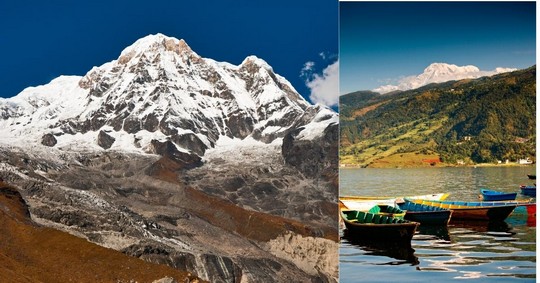
For Annapurna, you can choose between Annapurna Circuit and Annapurna Base Camp. Depending on the route you decide on, the hike could last between 14 to 18 days. It takes that long not only due to the distance but also because the itinerary will ensure that your body acclimatizes to the elevation properly.
The hiking season for Annapurna is either April to May or October to November. After these, hiking is not recommended or not even permitted due to bad weather. Regardless of which one you choose, both are relatively close to Pokhara.
RELATED HIKE: Inca Trail Hike, aka Machu Picchu Hike
Annapurna Circuit
The distance of Annapurna Circuit is about 160-230 kilometres (99-143 miles). And reaches over 5,000 metres (3 mi) elevation.
Annapurna is located right next to Pokhara. This trail starts in Kathmandu and ends in Pokhara. You will be transported from Pokhara to Kathmandu by driving. You can tell your tour guide if you want to stay in Pokhara or not.
Here’s a sample route for Annapurna Circuit:
- Kathmandu -> Jagat (drive)
- Jagat -> Dharapani
- Dharapani -> Chame
- Chame -> Pisang
- Pisang -> Manang
- Manang -> spend time to acclimatise
- Manage -> Yak Kharka
- Yak Kharka -> Torung Phedi
- Thorung La -> Muktinath
- Muktinath -> Marpha
- Marpha -> Kalopani
- Kalopani -> Pokhara (drive)
- Pokhra -> Kathmandu (drive)
Annapurna Base Camp
Also known as ABC Trek, it is 67 km (41.6 mi) long and takes about 6-7 days. The elevation reaches just over 4,100 m (2.5 mi).
While it is much shorter than Everest Base Camp and Annapurna Circuit, it is still recommended to be done carefully. You can also combine Annapurna Base Camp and Annapurna Circuit if you want.
Here’s a sample route for Annapurna Base Camp:
- Kande -> Landruk
- Landruk -> Lower Sinuwa
- Lower Sinuwa -> Deurali
- Deurali -> Annapurna Base Camp
- Annapurna Base Camp -> Upper Sinuwa
- Upper Sinuwa -> Ghandruk
Annapurna Trek Cost
You can either book a very convenient tour. The trekking permits will include English-speaking tour guides, accommodations, food, transportation, and even porters.
Annapurna Base Camp trek costs between $500-$7000 USD. In contrast, the Annapurna Circuit trek costs somewhere between $900-$1,100 USD.
If you want to save money, you can arrange everything yourself. Get a porter and a tour guide. A porter will help you carry your things but also will carry other items such as water, food, hiking items, etc.
Most days, you will be hiking for 8-12 hours a day and finding a store to buy snacks and water will be impossible. A guide will make sure you are on the right trail, communicate with the locals, and, of course, tell you information about the places you will see along the way.
By doing this, you might spend somewhere between $300-$500. It could be cheaper if you find other travellers and you can hire more porters but split the cost.
You can also do this on your own, saving you a lot of money. For one person, it will cost you about $180 per person for Annapurna Base Camp Trek. This includes accommodation, food, transportation, and permits. You will have to carry all your stuff and will not have a local guide.
Everest Base Camp
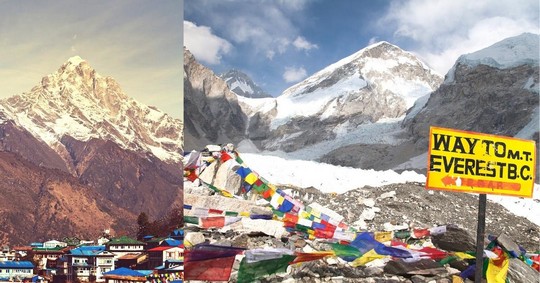
I have seen all the movies and documentaries on Everest Mountain, inspiring me to visit this place. Of course, I will not be able to do the actual hike (and cannot afford to do so), but I sure can hike to the Base Camp.
Many people believe it was expensive to summit Everest Mountain, and that’s true. But if you can’t afford that and honestly don’t have the skills to, you can still head to the Base Camp and see where the pro hikers are preparing before conquering the highest point of Earth. This is what we call the Everest Base Camp Hike (EBC).
Everest Base Camp Route
Head to Lukla (Tenzing Hillary Airport); there are only a few flights from Kathmandu (the flight to Lukla has been moved to Ramechhap Airport), so plan this in advance. The tour usually lasts between 12 to 15 days.
- Lukla -> Phakding
- Phakding -> Namche Bazaar
- Namche Bazaar – spend 2 days, and 1 night to acclimatise
- Namche Bazaar -> Tengboche
- Tengboche -> Dingboche
- Dingboche – spend 2 days, and 1 night to acclimatise, including a hike to Nangkartshang Peak
- Dingboche -> Lobuche
- Lobuche -> Gorak Shep -> Everest Base Camp -> back to Gorak Shep
- Gorak Shep -> Kala Patthar -> Pheriche
- Pheriche to Namche Bazaar
- Namche Bazaar -> Lukla
- Lukla -> Kathmandu
Everest Base Camp Trek Cost
If you book a tour, the Everest Base Camp hike costs between $1,000-$3,000 USD. The hike lasts for about 15 days. By booking a tour, you won’t have to worry about accommodation, water, trek permits, porter, and tour guides.
Everything will be taken care of, and you will be in the hands of experienced local hikers. You must get travel insurance that includes emergency evacuation for high-altitude locations.
Recommended EBC tours
You can book a tour where the agency will be in charge of everything. This often includes a tour, food, accommodation, and maybe drinks:
- airport pick up and drop off
- Lukla flight
- porter
- licensed guide
- accommodation
- salary/food/insurance of the staff
- all the permits required
- hotel in Kathmandu
Assembling Your Own Staff
UPDATE: EBC now requires a licensed local guide past Namche Bazaar. This means that you can no longer pass Namche Bazaar without a guide. However, this seems to still a touch and go. Some people managed to go on their own even after the announcement.
If you’re on a budget, you can arrange your own team. Meaning you talk to the locals and hire a guide and a porter. If you are more than 2 people, hire 2 porters. These porters will carry food, water, hiking equipment, and other essentials.
However, I suggest you arrange this in Kathmandu. You can visit a travel agency, and they will arrange the guide and porter which you will meet in Lukla (where the trek starts). In this way, you have some sort of security in case your porter or guide doesn’t show up or suddenly abandon you.
You don’t need to book your porter or guide a room or accommodation. They usually arrange this themselves or get a free/cheap room in return for bringing you (tourist) to the guest house.
How to do Everest Base Camp on Your Own
Get yourself to Lukla (Tenzing Hillary Airport). From here, you can start your trek on your own or gather your own staff. You can also simply start trekking, and if you change your mind about getting a porter or guide, you can do that in the next town.
MUST-PACK FOR TREKKING
Even though the hiking season is during the spring and fall months, bringing warm clothes and durable hiking shoes is still recommended.
You may also pack hiking poles. If you don’t bring hiking clothes, you can easily buy some in Pokhara or Kathmandu. There are also shops where you can rent the gear.
If you book from a travel agency, you should be able to rent items from them and leave the rest of your luggage. Only bring the necessities, first-aid kit, dry food, and other safety items. Read my safety tips for solo or first-time travellers.
TREKKING PERMITS
You have to obtain hiking permits, which are called the Trekkers Management System (TIMS). You can do this yourself or use a travel agency to help you get one. To get one, head to the Tourism Office either in Pokhara or Kathmandu. You can also extend your tourist visa in these offices.
TIMS costs between 1,000 to 3,000 NPR ($8-$25) depending on which trek you will be doing.
HELICOPTER EVACUATION INSURANCE
For treks above 5,000 m, everyone is required to secure travel insurance that specifically covers helicopter evacuation. Most insurance companies get strict when it comes to helicopters and would only cover specific nationalities. My friend was neither from the US, UK, Europe, or Australia.
She had a hard time finding a company to cover her. We reached out to the actual helicopter companies in Nepal, and unfortunately, you can’t get coverage directly from them. Instead, they recommended IMGlobal since they have worked with them many times.
IMGlobal has lots of different travel and medical insurance. But for helicopter evacuation, you should get the iTravelInsured Travel LX. It doesn’t have a limit on altitude and is specifically designed for extreme sports. This is what they recommend for the EBC trek and what my friend purchased.
SUMMARY OF 3 WEEKS IN NEPAL ITINERARY
Nepal offers so much more than Everest Mountain. If you are not a hiker, there are dozens of reasons to visit Nepal. Perhaps you are a yoga enthusiast, in that case, there are many yoga retreats for you to enjoy. There are also meditation centres and other places to help you improve your mind and body connection.
3 weeks in Nepal might sound too short, especially if you plan to do long hikes. But with plenty of planning, you will find the best way to explore this country and make the most of your 3-week holiday.
I hope that you found this article helpful. If you have other tips or miss something, leave us a comment below.
SAVE THIS 3-WEEK ITINERARY ON YOUR PINTEREST:
